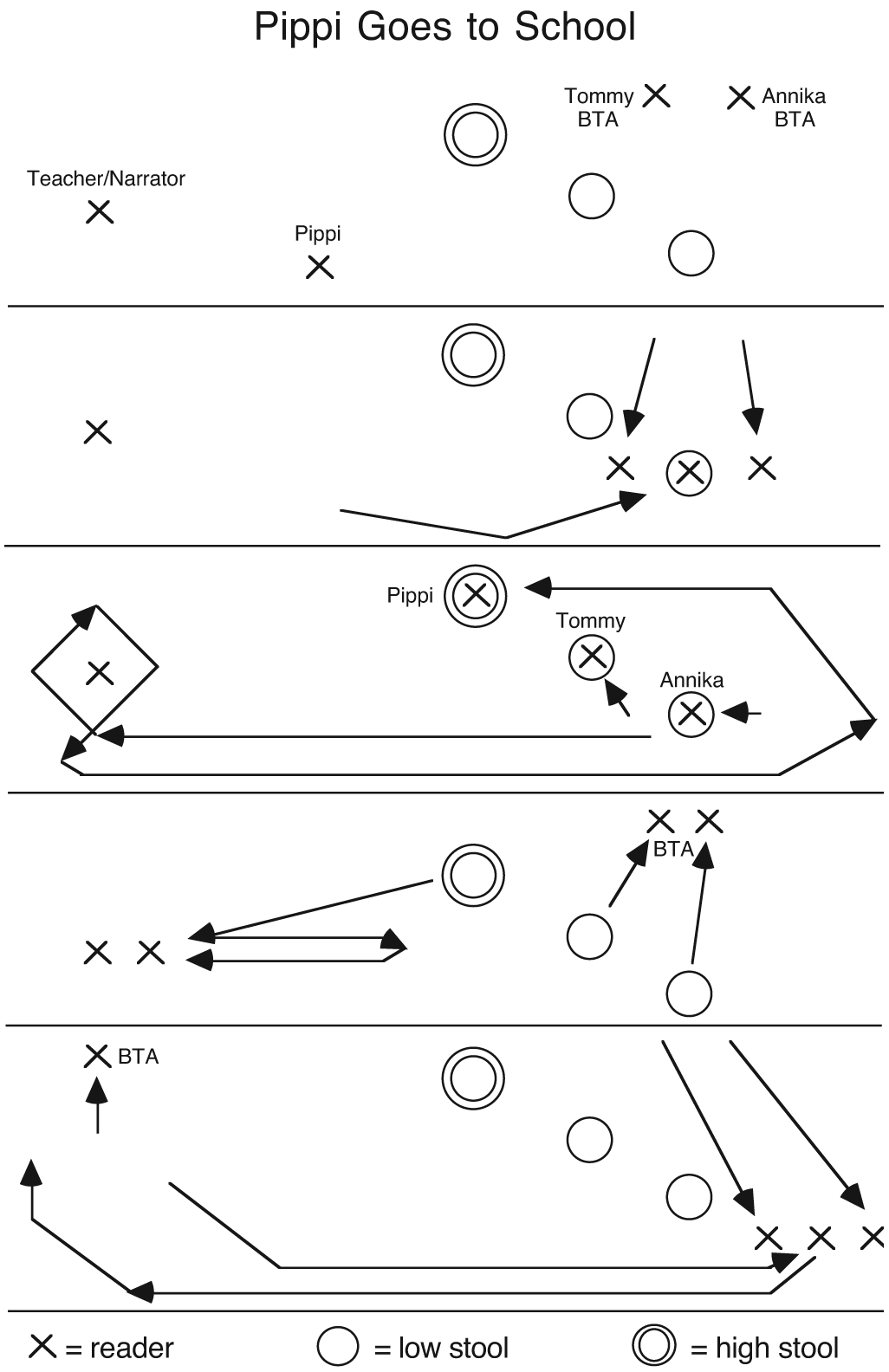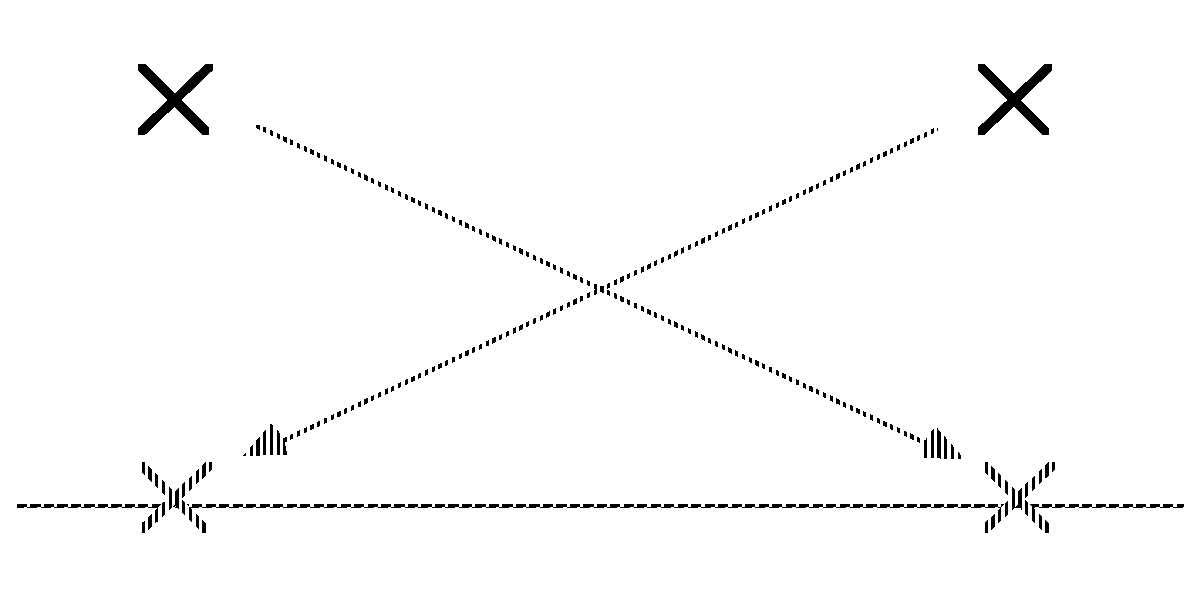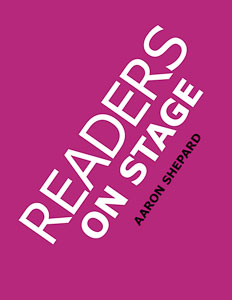Reader’s theater is often defined by what it is not—no memorizing, no props, no costumes, no sets. All this makes reader’s theater wonderfully convenient. Still, convenience is not its chief asset.
Like storytelling, reader’s theater can create images by suggestion that could never be portrayed realistically on stage. Space and time can be shrunk or stretched, fantastic worlds can be created, marvelous journeys can be enacted. Reader’s theater frees the performers and the audience from the physical limitations of conventional theater, letting the imagination soar.
Enjoy the magic of reader’s theater!
Styles
There are many styles of reader’s theater. In the simplest and most traditional:
Readers are arranged in a row or a semicircle, standing up or sitting on high stools. Typically, narrators are placed at one or both ends, and major characters in the center.
Scripts can be held in hand or set on music stands.
Readers look straight out toward the audience or at an angle, rather than at each other.
A very different style, designed for greater appeal to young audiences, has been developed by Chamber Readers, the group that provided my own start in reader’s theater. Chamber Readers is a professional, nonprofit reader’s theater company in Humboldt County, California, promoting reading and literature since 1975. For most of its first two decades—including my years with the group—it was directed by Jean Wagner, a founding member. Considered a local institution, Chamber Readers has performed yearly in almost every public school in the county.
Like traditional reader’s theater, the Chamber Readers style is based on the visible use of scripts and the suggestive power of language—but it adds a good deal of movement as well. Though that takes more effort, it’s also more rewarding and involving for both readers and audience.
Briefly, the distinctive features of the Chamber Readers style are:
Characters portray the action described in the story. Where possible, the portrayal is literal, with characters moving around the stage much as in a play. Where necessary, it’s suggestive, as with simple mime devices like walking in place.
Though narrators look mostly at the audience, characters look mostly at each other.
Scripts in sturdy binders are held in one hand, leaving the other hand free for acting.
A set of low stools and perhaps one or more high stools serve as versatile stage scenery or props.
The following tips on staging are based on the Chamber Readers style. But remember, these are suggestions only. I hope you’ll feel free to use or develop whatever style will be most enjoyable to you and your readers.
By the way, stage here refers simply to your performance area—which could be the front of a classroom, or an open space in a one‑room library, or one end of a school gym or cafeteria. An actual stage isn’t needed.
Equipment
For reader’s theater, you really need nothing but scripts. Still, a little basic equipment can add a lot. Here are some recommended items:
Script binders. Sturdy ring binders are best. Whatever you use, make sure the pages turn easily. Onstage the binder may also become a prop, standing in for a book, a notepad, the surface of a table.
Smocks. These give the readers a team look, yet are also neutral—so readers can easily change roles in the minds of the audience. The smock can be a simple rectangle of cloth with a head hole, fastened together at the sides.
Low stools. Stools of chair height are your most useful props. For some stories, you won’t need any; for others, you may need one for each reader. They must be sturdy enough to stand on!
High stools. One or two should be enough. These too should be sturdy enough to stand on—if you’ll allow such risk in the pursuit of art.
Folding screens. I refer to those freestanding, portable room dividers made of two or more panels hinged together. Though not required or even often seen in reader’s theater, they’re fun to use if available, providing alternative ways to handle entrances, exits, and some special effects.
Small props. These can sometimes add nice touches—as when a Pied Piper has a tin whistle to play.
Script Handling
The trick with scripts is to handle them so they can be referred to easily but don’t seriously restrict movement or distract the audience. The script is held by one hand alone, leaving the other hand free for acting. For a relaxed grip, readers simply let the binder spine rest in the palm. But if readers are moving a lot and need a firmer hold, they can reach forward and grip the binder’s top edge, while the binder rests on the upturned forearm.
Right‑handers hold a script with their left hand, left‑handers with their right. But sometimes a reader might have to switch hands, if a particular hand is needed for stage action, or if looking at the script turns the reader’s face too far from the audience. At times, a reader might even have to put the script down!
Though readers don’t need to memorize, they should know their parts well enough to look up from their scripts about half the time. (I call this “half‑memorizing.”) When they do look down, it’s only with the eyes, keeping the head straight up. In general, it’s best to look down when starting a sentence rather than when ending it, since the end is where delivery should be strongest.
You will have to be flexible in how scripts are used. A character who has to look steeply upward for much of a scene may have to memorize part of the script. A narrator who has a long speech may have to run a finger down the page to keep the place. A reader who won’t have a hand free to turn a page when needed can instead place that page backward in the binder to get two pages facing.
The Set
In theater lingo, the set is all the constructed “scenery” and large props placed onstage to represent one or more locations. In reader’s theater, you don’t build sets, but you can suggest them. What the narrator describes is made real by the characters’ movements and mime. If a reader opens a door, we see it. If readers hang ornaments on a Christmas tree, we know right where it is.
Stools are among your chief aids for suggesting sets, as well as being practical props. Three low stools in a semicircle can be a dining room. Two low stools close by each other can be a bench in a park, or a roof ridge atop a house. A single high stool can be a throne room. A high stool with a low stool next to it can be a tree to climb, or a mountain. An area with no stools can be anything at all!
As in regular theater, you start designing your set by figuring out what locations your script calls for. Then you position those locations on your stage in whatever arrangement works and looks best. Aim for ease of reader movement, stage balance, and openness to the audience.
Readers can move to different parts of the stage for different scenes. Or they can stay where they are and “change the set,” perhaps by moving the stools quickly to new positions. Or the set can move to them! For instance, a reader could move from room to room in a house just by walking in place, climbing some stairs, and opening some doors—all without moving an inch.
Reader Movement
After designing your set, decide where your readers will start and where they will go. As in regular theater, characters should be placed to help them face the audience as much as possible when speaking. And don’t forget the narrators! They can be placed wherever you want, but they usually stand forward at either end of the stage.
Characters normally stay “offstage” until needed in a scene. But in reader’s theater, this simply means that they stay turned with “back to audience”—BTA, for short. That indicates to the audience that the readers are out of the picture, even if visible. While staying BTA, the readers might either be sitting on stools or standing somewhere out of the other readers’ way, usually at the back of the stage. When it’s time to “enter,” they simply “turn in” and perhaps move forward. To “exit,” they do the opposite: “turn out” and perhaps move to the back. Narrators always face in, though, even when not reading for a long while.
In regular theater, the curtain or the lights coming down indicates a “scene change”—a jump in time or place. In reader’s theater, this change is shown instead by some kind of break in movement. For instance, the characters can all “freeze” in place like statues. Or they can turn BTA, freeze, then come back in. Or they can freeze, then cross the stage for the next scene. But you can do without any break at all if one scene flows smoothly into the next without a jump.
Drawing a series of movement diagrams can help you spot problems, save time during rehearsal, and jog your memory the next time you use the script. In one simple diagram system, circles are low stools, double circles are high stools, crosses are readers, and arrows show movement. The diagrams are oriented to audience view, with the stage edge at bottom. Here’s an example:

Sample movement diagrams (PDF, 1 page)
Mime and Sound Effects
Whatever action is described in the script, readers should try either to do it or else to suggest it through mime. If someone is eating, we should see the fork carried to the mouth. If someone is hanging in the air, we should see the arm pulled tight by the floating balloon. If someone is racing a horse, we should see the galloping hooves.
The key word here is “suggest,” because the movements are often far from realistic. For instance, it’s hard to take off a coat realistically when one hand holds a script. Readers quickly learn to sleep sitting up, with their heads bent to the side. And walking in place is a reader’s favorite mode of travel.
Though formal mime techniques aren’t required, they do add polish to a performance. It’s always good to draw on proven tricks for walking in place, climbing up or down stairs or ropes or ladders, lifting or pulling heavy objects, flying, falling, and so on. Look for a beginning book on mime, or invite a local mime to conduct a workshop.
Part of successful group mime is being aware of the invisible. If a stool is meant to be a chair at a table, make sure no one walks through the table! Even a door that’s invisible shouldn’t shift position as different people pass through it. If two characters look at a picture on the wall, they will hopefully agree where it is!
Sounds in the story too should be added where possible—explosions, wind, bees, roosters, whatever. To help the illusion, this is usually done by readers with backs to the audience.
Focus
Focus refers to where a reader is looking. Most of the time, it’s simple: Narrators use audience focus—they look straight at the audience, even when the audience isn’t looking at them. Characters use onstage focus—they look at whoever they’re talking to, just as in plays or real life.
But sometimes you might want characters to use offstage focus. (See the illustration below.) The readers imagine a screen facing them, as wide as the stage, set up at the front edge of the audience. On this screen they imagine projected images of all the readers. Then instead of talking straight to each other, they talk to each other’s projection on the screen. If you prefer, you can “move” the screen farther from the readers, as long as everyone agrees where it is.
Offstage Focus

The most important use of offstage focus is to help create illusions of distance or height. With offstage focus, two characters on the same stage can shout and wave at each other as if a mile apart. Or if one looks upward and one looks downward, you have a midget talking to a giant, or a woman in a window talking to a man in the street.
Audience focus too can at times be used by characters, for making comments directly to the audience. It might also be used to draw the audience into the story—for example, if the audience suddenly becomes a hill completely covered with cats.
At times, a narrator too can use onstage or offstage focus. This is good for interactions between narrators or between narrator and character—which can be fun or startling because they defy the convention of narrator isolation. It could also be used to insert the narrator partway into the story as a personal observer and commenter. (Think of the Stage Manager in Thornton Wilder’s Our Town, a play sharing many conventions with this style of reader’s theater.)
Finally, a reader who doubles as narrator and character might use a different focus for each, with a shift in focus signaling a shift in roles.
Beginnings and Endings
The effectiveness of your performance as a whole and of each story within it is enhanced when all are “set off” with proper beginnings and endings. The following are recommended:
At the beginning of the performance come a few words of greeting and introduction from one or more readers, who identify the group and tell anything else about why it’s there and what it’s presenting.
Then before each story is performed, it’s introduced individually, again by one or more readers, who tell something about the story or the author or the performance. The intro can present a fact or an idea or an anecdote or even a question. Just don’t give away the plot!
Intros should always be prepared ahead of time, whether or not they’re written down. They’re most effective when delivered informally but can also be memorized, delivered from notes, or just read directly. Generally, no more than a few sentences is needed or wanted. Often the content is left to the reader and can vary according to who gives that intro during a particular performance.
Following the story intro, the title and the author are announced, along with the name of the larger work if your script is an excerpt. Most often, the announcement is tacked onto the intro by a simple, “And now, here is . . . ,” or something similar. Then the readers wait to begin till they’re all in place and frozen and the audience is quiet and attentive.
As the story ends, the last words are spoken slowly and with exaggerated rhythm, so the audience knows the story is over. Everyone recognizes the ending “hap‑pily ev‑er af‑ter.” But the same effect can be achieved with almost any words by reading them in a “slow three,” using stressed syllables to form three strong “beats.”
Next, the readers freeze for a long moment to break the action. Then they close their scripts, face the audience squarely, and bow all together. To help time this sequence, you can have the readers count slowly to themselves. You might also pick one reader toward the front of the stage—probably a narrator—to lead it.
For individual stories, nothing follows the bow. Any comments added at the end can only weaken the story’s impact. But the final story is followed by a few words of thanks and farewell.
When rehearsing, always include your beginnings and endings along with the rest, to make sure they’ll go smoothly in performance.
Once young people have a general idea of how reader’s theater works, they can take over much of the staging themselves. In fact, they often beat adults at developing mime.
After all, pretending is part of their profession.
